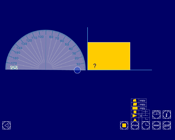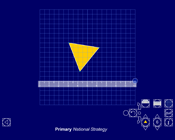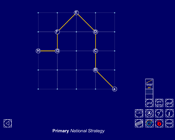Consolidation and practice
These resources are to support children in guided or independent work.
Calculating angles

This interactive teaching program (ITP) is an ICT-based tool to support the exploration of angles. Calculating angles ITP allows the child or teacher to represent single or multiple shapes rotated around a central point in one, two or four quadrants. The size of angles can be estimated or calculated and confirmed using the on-screen protractor or reveal function.
Polygon

This interactive teaching program (ITP) is an ICT-based tool to support the exploration of shape, space and measure. Polygon ITP allows the child or teacher to represent regular polygons with three to ten sides. The ITP can then be used to explore the properties of regular and irregular shapes by dragging vertices and creating additional vertices. The ITP includes an on-screen protractor and ruler.
Fixing points

This interactive teaching program (ITP) is an ICT-based tool to support the exploration of shape and space. Fixing points ITP allows the child or teacher to create one or more shapes by connecting a number of vertices on a grid. Angles can be estimated and measured, and the effect of moving different vertices can be explored.
Opportunities to use and apply
Possible contexts include:
- money, e.g. Total a shopping bill such as 45p + 32p + 55p + 12p.
- measures, e.g. I have 360 ml of juice in a jug. I add another 450 ml. How much juice is there in the jug now?
- application to calculations where known facts and place value can be used to add and subtract a pair of numbers mentally, e.g. Using knowledge of 62 − 38 to calculate
6200 − 3800 or 6.2 − 3.8.
- solving problems, e.g. Completing number pyramids.

Confirming learning
Ask probing questions such as:
- The difference between two two-digit numbers is 13. What could the two-digit numbers be? If one of the numbers is between 50 and 60 what could the numbers be?
- How could you quickly calculate the answer to 93 − 86? Why did you choose that strategy?
- Use numbers greater than 20 to make up an addition that has the answer 87.
- The total of two numbers is 33 and their difference is 7. What are the numbers? What would they be if the total was 3.3 and the difference 0.7? How do you know?
 Calculating
Calculating



